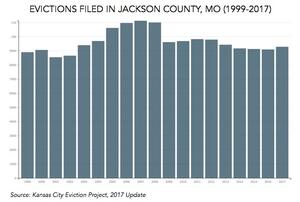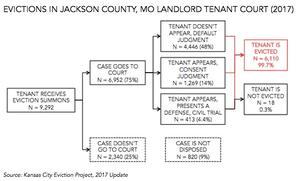
Kansas City Eviction Research Highlights the Need for Bold Municipal Solutions
by Tara Raghuveer, Founder and Director, Kansas City Eviction Project
The nation’s housing crisis has reached emergency levels. In 2018, a person working full time in a minimum-wage job cannot afford a two-bedroom apartment in any US county. More than half of all Americans spend over 30 percent of their income on housing. Only one in five households qualifying for federal housing assistance receives it, leaving more people to rent from private landlords than ever before. Under these conditions, most people—especially low-income people and communities of color—live one emergency away from an eviction.
Eviction provides a clear window for understanding housing, racial injustice, and poverty in cities. In the face of the eviction crisis, national researchers, community organizers, and other civic actors have rallied together to document data and call attention to this crisis. One of these collective efforts is the Kansas City Eviction Project (KC Eviction Project), a collaboration between researchers, community organizers, neighborhood leaders, lawyers, and policymakers.
Metropolitan Kansas City sprawls across the Kansas-Missouri state line and encompasses five counties. The metropolitan area contains an urban core, suburban, and rural communities. Two million people live in the metropolitan area, and about 480,000 live in the city itself. Kansas City is comparable in size with other midwestern cities like St. Louis and Denver.
Like many other American cities, Kansas City is marked by a long history of segregationist real estate practices, the ramifications of which are still felt today. Kansas City’s Troost Avenue is widely seen as the city’s racial and economic dividing line. Kansas City neighborhoods have faced rapid change in recent years as more people rent in the private market than before the financial crisis, more young people stay in the city as renters, corporations expand their presence downtown, and developers invest in Kansas City’s midsize rental market.
KC Eviction Project compiled a dataset of evictions in Jackson County, Missouri, which encompasses most of metropolitan Kansas City, Missouri. The data, obtained through county court electronic records, include eviction filings from 1999 to 2017. The data are at the address level and have been geocoded and mapped. These data, like most data on evictions, are limited in that they show only formal evictions. Other evictions happen informally outside the courts and with no data to represent them.
The project has led to some important findings:
Eviction filings. On average, 42 formal evictions have been filed each business day in Jackson County since 1999, or about 9,000 a year. That number represents only a fraction of total forced moves. Eviction filings have remained consistent year over year, suggesting that there are renters in Kansas City for whom paying the rent in full is financially impossible and that there could be landlords for whom eviction is a business model.
Causes of eviction. Rent and possession filings, evictions filed because of nonpayment of rent, have increased substantially since 2012 and are at their highest levels in at least 18 years. The filings on the basis of rent nonpayment suggest mounting strains in Kansas City’s rental market related to a shrinking supply of affordable units and increased churn in the rental market because of recent development.
Race and evictions. Race is the most important factor in predicting whether a person will be evicted in Kansas City. Even when holding income constant, we find black people are evicted at a higher rate, and eviction has the deepest impact on neighborhoods in Kansas City with a greater population of black or brown residents. In parts of the city that are majority white, evictions are lower.
Eviction in the courts. Of the 9,292 evictions filed in Jackson County in 2017, 75 percent made it to the landlord-tenant docket where a judge heard the eviction case. In 2017, the landlord won 99.7 percent of the cases that made it to the landlord docket and were disposed in court. Of the 6,952 eviction cases heard by the landlord-tenant docket in 2017, the tenant prevailed in only 18 cases. Judges decided 4,446 cases in favor of the landlord because the tenant did not appear in court, a default judgment. The KC Eviction Project’s analysis of eviction in the courts between 2006 and 2016 shows 84 percent of landlords have lawyers, while only 1.3 percent of tenants have representation. Tenants who have representation win in court significantly more often than those who do not have representation, and tenants win more frequently when landlords represent themselves without a lawyer. Tenants who could afford or attract counsel likely had stronger claims. Even so, the data demonstrate that legal representation matters.
New evictors. As the real estate landscape in Kansas City had evolved, the actors filing evictions have changed. Limited liability companies (LLCs) filed 4,125 of the 9,292 evictions filed in 2017. LLC eviction filings have increased 30 percent since 2016 and 311 percent since 2007. Owning real estate as an LLC or other corporate entity, as opposed to owning as an individual, is an increasingly popular practice nationally. In 1991, individuals held 92 percent of rental properties in America. By 2015, that share had fallen to 74 percent, driven largely by the growth of LLC holdings. Though LLC ownership of rental property is legal, it brings significant burdens for cities and tenants. LLCs can shield property owners from personal liability while obscuring their identities. This anonymity can make it harder for tenants, community members, and cities to hold landlords accountable.
KC Eviction Project has some of the most complete information about evictions in the country. But we still don’t know the scope of the problem in Kansas City because of informal evictions outside the court system. The lack of robust data on evictions contributes to a nationwide trend wherein municipalities propose “solutions” that fall short of what is necessary to solve eviction’s root causes.
Given the breadth and depth of the emergency, cities must pursue a comprehensive slate of solutions to the broader affordable housing crisis, not just evictions. What would it take to guarantee that every person in Kansas City had access to a truly and permanently affordable, healthy, accessible, and safe home? When policymakers imagine solutions to the eviction epidemic, they should orient themselves based on this question.
Such a comprehensive housing strategy should prioritize public investment in preserving and rehabilitating truly affordable rental stock, eviction-specific policies, regulation of the private market, a racial justice agenda that includes equitable representation in courts, and more.
Kansas City and cities like it have an urgent opportunity for intervention. Evictions are not new, but their impact is becoming more acute. Low-income people and communities of color have not yet been priced out of places like Kansas City—but they will be if policymakers fail to implement systemic reforms and policy solutions that are bold and proactive enough to match the magnitude of the crisis.
Photo by AG Baxter/Shutterstock





